-
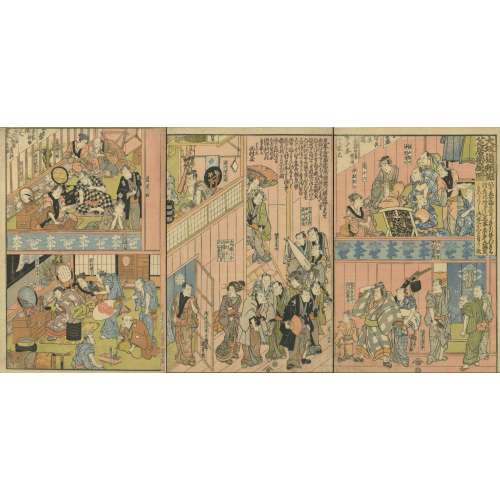 Artist: Utagawa Kunisada [歌川 国貞] a.k.a. Utagawa Toyokuni III [三代歌川豊国] (Japanese, 1786 – 1865). Publisher: Nishimuraya Yohachi [西村屋与八] (Japanese, fl. c. 1751 – 1860), seal name: Eijudō. Date: c. 1821–22 (Bunsei 4–5) Size: Ōban tate-e triptych, each sheet 36.8 x 26.4 cm. Signed: 五渡亭国貞画 – Gototei Kunisada ga (on center sheet). Censor’s seal: kiwame 改印: 極 A view of the dressing room of a Theater in Dōtonbori, Ōsaka (Ōsaka Dōtonbori shibai gakuya no zu): Right sheet: Actors Bandō Mitsuemon I, Asao Tamejūrō III, Ichikawa Danzō V, Nakamura Utaemon III, Bandō Mitsugorō III (in a costume of Matsuômaru), Kiriyama Monji III, Nakamura Utashichi II, Arashi Shôroku IV, Nakamura Matsue III, Matsumoto Kōshirō V, Ichikawa Komazō V. Centre sheet: Arashi Mitsugorō III, Mimasu Daigorō III, Nakayama Bunshichi III, Ichikawa Ichizō II, Bandō Minosuke II, Ichikawa Omezō I, Arashi Kitsusaburō I, Nakamura Utaroku I, Kataoka Nizaemon VII, Ōtani Tomoemon III, Asao Yūjirō I. Left sheet: Asao Kuzaemon I, Arashi Hidenosuke III, Sawamura Gennosuke II, Iwai Ōginosuke, Sawamura Kunitarō II, Iwai Matsunosuke I, Ichikawa Sōzaburō IV, Iwai Hanshirō V (in a costume of Sakuramaru), and Ichikawa Shinzō III (L). The actors are making up for a performance of the “Carriage-Stopping” scene from Sugawara Denju Tenarai Kagami (Sugawara Denju and the Secrets of Calligraphy). References: MFA Accession №: 11.43384a-c; Catalogue Raisonné: Izzard, Kunisada’s World (1993), #34; Hizô Ukiyo-e taikan/Ukiyo-e Masterpieces in European Collections 5, Victoria and Albert Museum II (1987), pl. 22; Keyes, PMA Osaka cat. (1973), #250 and pl. 15 (The theatrical world of Osaka prints, by Roger S. Keyes and Keiko Mizushima, Philadelphia Museum of Art, 1973), pp. 70-71); Izzard, Kunisada's world revisited, 2021; V&A Accession № E.5995-1886. Kabuki actors on this print: Arashi Hidenosuke III [嵐秀之助] (Japanese, fl. 1794 – 1837); other names: Arashi Koshichi IV, Arashi Hinasuke IV, Arashi Sanjūrō VI, Kanō Hidenosuke II, Kanō Umetarō, Arashi Iwajirō III. Arashi Kitsusaburō I [嵐橘三郎] (Japanese, 1769 – 1821); other names: Arashi Kichisaburō II, Arashi Rikan I. Arashi Mitsugorō III (Japanese, ? – ?) Arashi Shōroku IV [四代目嵐小六] (Japanese, 1783 – 1826) Asao Kuzaemon I [浅尾工左衛門] (Japanese, 1758 – 1824); other names: Asai Kuzaemon Nakayama Tashirō II Takeda Nisaburō. Asao Tamejūrō III [三代目淺尾爲十郎] (Japanese, 1780 – 1836); other names: Asao Okuyama III, Asao Okuyama III, Asao Tomozō I. Asao Yūjirō I [浅尾勇次郎] (Japanese, 1782 – 1835); other names: Jitsukawa Gakujūrō I, Asao Gakujūrō, Nakamura Yaozō, Asao Yaozō. Bandō Minosuke II [坂東蓑助] (Japanese, 1802 – 1863); other names: Morita Kan'ya XI, Bandô Mitsugorō IV. Bandō Mitsuemon I [坂東三津右衛門] (Japanese, 1788 – 1846); other names: Bandō Kumahei [坂東熊平]. Bandō Mitsugorō III [三代目 坂東 三津五郎] (Japanese, 1775 – 1831); other names: Bandō Minosuke I, Morita Kanjirô II, Bandō Mitahachi I, Bandō Minosuke I, Bandō Mitahachi I. Ichikawa Danzō V [市川団蔵] (Japanese, 1788 – 1845); other names: Ichikawa Shikō I, Ichikawa Danzaburō IV, Ichikawa Danjirō I, Ichikawa Morinosuke I. Ichikawa Ichizō II [市川市蔵] (Japanese, 1806 – 1829); other names Ichikawa Ebijūrō II, Ichikawa Sukezō I. Ichikawa Komazō V [市川高麗蔵] (Japanese, 1812 – 1849); other names: Matsumoto Kinshō I, Matsumoto Kōshirō VI, Matsumoto Kinshi. Ichikawa Omezō I [市川男女蔵] (Japanese, 1781 – 1833); other names: Ichikawa Benzō II, Ichikawa Bennosuke. Ichikawa Shinzō III [市川新蔵] (Japanese, 1793 – 1837); other names: Ichikawa Sumizō III, Nakayama Tomisaburô II, Nakayama Kinsha, Nakayama Tomisaburō II, Ichikawa Komazō IV, Ichikawa Santarō. Ichikawa Sōzaburō IV (Japanese, ? – ?) Iwai Hanshirō V [岩井半四郎] (Japanese, 1776 – 1847); other names: Iwai Tojaku, Iwai Kumesaburō I. Iwai Matsunosuke I [岩井松之助] (Japanese, 1804 – 1845); other names: Iwai Hanshirō VII, Iwai Shijaku I, Iwai Komurasaki I. Iwai Ōginosuke (Japanese, ? – ?) Kataoka Nizaemon VII [七代目片岡仁左衛門] (Japanese, 1755 – 1837); other names: Yamazawa Kunigorō, Asao Kunigorō II, Nakamura Matsusuke. Kiriyama Monji III [桐山紋治] (Japanese, fl. c. 1803 – 1830); other names: Ichikawa Takigorō. Matsumoto Kōshirō V [五代目松本幸四郎] (Japanese, 1764-1838); other names: Ichikawa Komazô III, Ichikawa Sumizô I. Mimasu Daigorō III [三枡大五郎] (Japanese, 1782 – 1824); other names: Mimasu Seibē, Yoshizawa Kamezō. Nakamura Matsue III [三代目中村松江] (Japanese, 1786-1855); other names: Nakamura Sankō I, Nakamura Tomijūrō II, Ichikawa Kumatarō. Nakamura Utaemon III [中村歌右衛門] (Japanese, 1778 – 1838); other names: Nakamura Tamasuke, Nakamura Baigyoku I, Nakamura Shikan I, Kagaya Fukunosuke I. Nakamura Utaroku I (Japanese, ? – ?) Nakamura Utashichi II (Japanese, ? – ?) Nakayama Bunshichi III [三代目目中山文七] (Japanese, 1764 – 1853); other names: Nakayama Hyakka, Nakayama Hyōtarō I, Nakayama Tokusaburō. Ōtani Tomoemon III [大谷友右衛門] (Japanese, 1793–1839); other names: Arashi Shagan IV, Arashi Sanpachi II, Nakayama Monzaburō. Sawamura Gennosuke II [沢村源之助](Japanese, 1802/7 – 1853); other names: Suketakaya Takasuke III, Sawamura Chōjūrō V, Sawamura Sōjūrō V, Sawamura Tosshō I, Sawamura Genpei I. Sawamura Kunitarō II [沢村国太郎](Japanese, 1798 – 1836); other names: Ogino Kinshi, Ogino Yaegiri III, Ogino Kamekichi, Izumikawa Kamekichi.
Artist: Utagawa Kunisada [歌川 国貞] a.k.a. Utagawa Toyokuni III [三代歌川豊国] (Japanese, 1786 – 1865). Publisher: Nishimuraya Yohachi [西村屋与八] (Japanese, fl. c. 1751 – 1860), seal name: Eijudō. Date: c. 1821–22 (Bunsei 4–5) Size: Ōban tate-e triptych, each sheet 36.8 x 26.4 cm. Signed: 五渡亭国貞画 – Gototei Kunisada ga (on center sheet). Censor’s seal: kiwame 改印: 極 A view of the dressing room of a Theater in Dōtonbori, Ōsaka (Ōsaka Dōtonbori shibai gakuya no zu): Right sheet: Actors Bandō Mitsuemon I, Asao Tamejūrō III, Ichikawa Danzō V, Nakamura Utaemon III, Bandō Mitsugorō III (in a costume of Matsuômaru), Kiriyama Monji III, Nakamura Utashichi II, Arashi Shôroku IV, Nakamura Matsue III, Matsumoto Kōshirō V, Ichikawa Komazō V. Centre sheet: Arashi Mitsugorō III, Mimasu Daigorō III, Nakayama Bunshichi III, Ichikawa Ichizō II, Bandō Minosuke II, Ichikawa Omezō I, Arashi Kitsusaburō I, Nakamura Utaroku I, Kataoka Nizaemon VII, Ōtani Tomoemon III, Asao Yūjirō I. Left sheet: Asao Kuzaemon I, Arashi Hidenosuke III, Sawamura Gennosuke II, Iwai Ōginosuke, Sawamura Kunitarō II, Iwai Matsunosuke I, Ichikawa Sōzaburō IV, Iwai Hanshirō V (in a costume of Sakuramaru), and Ichikawa Shinzō III (L). The actors are making up for a performance of the “Carriage-Stopping” scene from Sugawara Denju Tenarai Kagami (Sugawara Denju and the Secrets of Calligraphy). References: MFA Accession №: 11.43384a-c; Catalogue Raisonné: Izzard, Kunisada’s World (1993), #34; Hizô Ukiyo-e taikan/Ukiyo-e Masterpieces in European Collections 5, Victoria and Albert Museum II (1987), pl. 22; Keyes, PMA Osaka cat. (1973), #250 and pl. 15 (The theatrical world of Osaka prints, by Roger S. Keyes and Keiko Mizushima, Philadelphia Museum of Art, 1973), pp. 70-71); Izzard, Kunisada's world revisited, 2021; V&A Accession № E.5995-1886. Kabuki actors on this print: Arashi Hidenosuke III [嵐秀之助] (Japanese, fl. 1794 – 1837); other names: Arashi Koshichi IV, Arashi Hinasuke IV, Arashi Sanjūrō VI, Kanō Hidenosuke II, Kanō Umetarō, Arashi Iwajirō III. Arashi Kitsusaburō I [嵐橘三郎] (Japanese, 1769 – 1821); other names: Arashi Kichisaburō II, Arashi Rikan I. Arashi Mitsugorō III (Japanese, ? – ?) Arashi Shōroku IV [四代目嵐小六] (Japanese, 1783 – 1826) Asao Kuzaemon I [浅尾工左衛門] (Japanese, 1758 – 1824); other names: Asai Kuzaemon Nakayama Tashirō II Takeda Nisaburō. Asao Tamejūrō III [三代目淺尾爲十郎] (Japanese, 1780 – 1836); other names: Asao Okuyama III, Asao Okuyama III, Asao Tomozō I. Asao Yūjirō I [浅尾勇次郎] (Japanese, 1782 – 1835); other names: Jitsukawa Gakujūrō I, Asao Gakujūrō, Nakamura Yaozō, Asao Yaozō. Bandō Minosuke II [坂東蓑助] (Japanese, 1802 – 1863); other names: Morita Kan'ya XI, Bandô Mitsugorō IV. Bandō Mitsuemon I [坂東三津右衛門] (Japanese, 1788 – 1846); other names: Bandō Kumahei [坂東熊平]. Bandō Mitsugorō III [三代目 坂東 三津五郎] (Japanese, 1775 – 1831); other names: Bandō Minosuke I, Morita Kanjirô II, Bandō Mitahachi I, Bandō Minosuke I, Bandō Mitahachi I. Ichikawa Danzō V [市川団蔵] (Japanese, 1788 – 1845); other names: Ichikawa Shikō I, Ichikawa Danzaburō IV, Ichikawa Danjirō I, Ichikawa Morinosuke I. Ichikawa Ichizō II [市川市蔵] (Japanese, 1806 – 1829); other names Ichikawa Ebijūrō II, Ichikawa Sukezō I. Ichikawa Komazō V [市川高麗蔵] (Japanese, 1812 – 1849); other names: Matsumoto Kinshō I, Matsumoto Kōshirō VI, Matsumoto Kinshi. Ichikawa Omezō I [市川男女蔵] (Japanese, 1781 – 1833); other names: Ichikawa Benzō II, Ichikawa Bennosuke. Ichikawa Shinzō III [市川新蔵] (Japanese, 1793 – 1837); other names: Ichikawa Sumizō III, Nakayama Tomisaburô II, Nakayama Kinsha, Nakayama Tomisaburō II, Ichikawa Komazō IV, Ichikawa Santarō. Ichikawa Sōzaburō IV (Japanese, ? – ?) Iwai Hanshirō V [岩井半四郎] (Japanese, 1776 – 1847); other names: Iwai Tojaku, Iwai Kumesaburō I. Iwai Matsunosuke I [岩井松之助] (Japanese, 1804 – 1845); other names: Iwai Hanshirō VII, Iwai Shijaku I, Iwai Komurasaki I. Iwai Ōginosuke (Japanese, ? – ?) Kataoka Nizaemon VII [七代目片岡仁左衛門] (Japanese, 1755 – 1837); other names: Yamazawa Kunigorō, Asao Kunigorō II, Nakamura Matsusuke. Kiriyama Monji III [桐山紋治] (Japanese, fl. c. 1803 – 1830); other names: Ichikawa Takigorō. Matsumoto Kōshirō V [五代目松本幸四郎] (Japanese, 1764-1838); other names: Ichikawa Komazô III, Ichikawa Sumizô I. Mimasu Daigorō III [三枡大五郎] (Japanese, 1782 – 1824); other names: Mimasu Seibē, Yoshizawa Kamezō. Nakamura Matsue III [三代目中村松江] (Japanese, 1786-1855); other names: Nakamura Sankō I, Nakamura Tomijūrō II, Ichikawa Kumatarō. Nakamura Utaemon III [中村歌右衛門] (Japanese, 1778 – 1838); other names: Nakamura Tamasuke, Nakamura Baigyoku I, Nakamura Shikan I, Kagaya Fukunosuke I. Nakamura Utaroku I (Japanese, ? – ?) Nakamura Utashichi II (Japanese, ? – ?) Nakayama Bunshichi III [三代目目中山文七] (Japanese, 1764 – 1853); other names: Nakayama Hyakka, Nakayama Hyōtarō I, Nakayama Tokusaburō. Ōtani Tomoemon III [大谷友右衛門] (Japanese, 1793–1839); other names: Arashi Shagan IV, Arashi Sanpachi II, Nakayama Monzaburō. Sawamura Gennosuke II [沢村源之助](Japanese, 1802/7 – 1853); other names: Suketakaya Takasuke III, Sawamura Chōjūrō V, Sawamura Sōjūrō V, Sawamura Tosshō I, Sawamura Genpei I. Sawamura Kunitarō II [沢村国太郎](Japanese, 1798 – 1836); other names: Ogino Kinshi, Ogino Yaegiri III, Ogino Kamekichi, Izumikawa Kamekichi. -
 Onin Tsuba with two overlapping lozenges, or interlocked diamond shapes. Iron and brass. Sukashi and ten-zogan technique. Muromachi period. Diameter: 81.0 mm; Thickness at seppa-dai: 3.2 mm The symbol of two overlapping lozenges (or, interlocked diamond shapes), presumably a family crest (kamon) may be deciphered as chigai kuginuki (nail extraction tool => 'conquered nine castles' ) or as chigai bishi (overlapping lozenges). Similar symbol can be found at Butterfield & Butterfield. IMPORTANT JAPANESE SWORDS, SWORD FITTINGS AND ARMOR. Auction Monday, November 19th, 1979. Sale # 3063], №94 with the following explanation: " This was the mon (crest) of the Yonekura family of Kaga Prov., at Kanazawa". An interesting insight is provided by Robert E. Haynes at Important Japanese kodogu, gaiso and works of art. San Francisco, April 9-11, 1982. Robert E. Haynes, Ltd., № 36 (see photo): "This would seem to be the Yonekura family mon. They were Seiwa-Genji Daimyō family made noble in 1696 and resided in Kanazawa in Kaga". Would it be possible that this is a late 17th century Ōnin tsuba?
Onin Tsuba with two overlapping lozenges, or interlocked diamond shapes. Iron and brass. Sukashi and ten-zogan technique. Muromachi period. Diameter: 81.0 mm; Thickness at seppa-dai: 3.2 mm The symbol of two overlapping lozenges (or, interlocked diamond shapes), presumably a family crest (kamon) may be deciphered as chigai kuginuki (nail extraction tool => 'conquered nine castles' ) or as chigai bishi (overlapping lozenges). Similar symbol can be found at Butterfield & Butterfield. IMPORTANT JAPANESE SWORDS, SWORD FITTINGS AND ARMOR. Auction Monday, November 19th, 1979. Sale # 3063], №94 with the following explanation: " This was the mon (crest) of the Yonekura family of Kaga Prov., at Kanazawa". An interesting insight is provided by Robert E. Haynes at Important Japanese kodogu, gaiso and works of art. San Francisco, April 9-11, 1982. Robert E. Haynes, Ltd., № 36 (see photo): "This would seem to be the Yonekura family mon. They were Seiwa-Genji Daimyō family made noble in 1696 and resided in Kanazawa in Kaga". Would it be possible that this is a late 17th century Ōnin tsuba?
Robert E. Haynes Catalog of April 9-11, 1982, № 36.
-
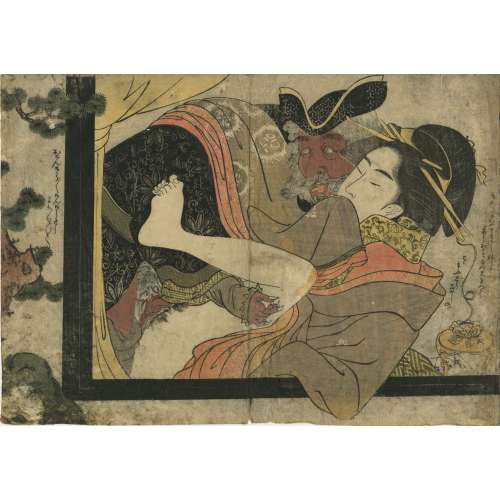 Woodblock print album of thirteen prints, ōban, nishiki-e. Artist: Chōkyōsai Eiri [鳥橋斎 栄里] (Japanese, fl. c. 1789 ~ 1801 ). Models of calligraphy (Fumi no kiyogaki), New Year 1801. This title is taken from Chris Uhlenbeck's Japanese Erotic Fantasies Sexual Imagery of the Edo Period. — Hotei Publishing, 2005, ISBN 90-74822-66-5):. A detailed description of the album can be found at The Complete Ukiyo-e Shunga №9 Eiri, 1996, ISBN 4-309-91019. Most of the edition is in Japanese, though Richard Lane writes a section in English: Eiri: Love-letters, Love Consummated: Fumi-no-kiyogaki. The article starts with the following statement: "Why all the fuss about Sharaku? Because he is so "mysterious"? No, not at all: because he is such a good artist. But Sharaku is not the only great yet enigmatic ukiyo-e artist and I propose to resurrect here one of his important contemporaries who has been all too long neglected: Chōkyōsai Eiri. As with many of the notable ukiyo-e masters, nothing is known of Eiri's biography. All we can say is what we learn from his extant prints and paintings: that he flourished during the second half of the Kansei Period [1789-1801]; and that he was a direct pupil of the great Eishi - who, being of eminent samurai stock, may well have attracted pupils of similar background." Another citation from Japanese Erotic Fantasies: "This album is one of the boldest sets of ōban-size shunga known, The first edition contains thirteen instead of the customary twelve designs". Here I present all thirteen prints, though the edition I bought in Kyoto in 2014 contained only twelve. The thirteenth print was purchased later in the United States (sheet №12).
Woodblock print album of thirteen prints, ōban, nishiki-e. Artist: Chōkyōsai Eiri [鳥橋斎 栄里] (Japanese, fl. c. 1789 ~ 1801 ). Models of calligraphy (Fumi no kiyogaki), New Year 1801. This title is taken from Chris Uhlenbeck's Japanese Erotic Fantasies Sexual Imagery of the Edo Period. — Hotei Publishing, 2005, ISBN 90-74822-66-5):. A detailed description of the album can be found at The Complete Ukiyo-e Shunga №9 Eiri, 1996, ISBN 4-309-91019. Most of the edition is in Japanese, though Richard Lane writes a section in English: Eiri: Love-letters, Love Consummated: Fumi-no-kiyogaki. The article starts with the following statement: "Why all the fuss about Sharaku? Because he is so "mysterious"? No, not at all: because he is such a good artist. But Sharaku is not the only great yet enigmatic ukiyo-e artist and I propose to resurrect here one of his important contemporaries who has been all too long neglected: Chōkyōsai Eiri. As with many of the notable ukiyo-e masters, nothing is known of Eiri's biography. All we can say is what we learn from his extant prints and paintings: that he flourished during the second half of the Kansei Period [1789-1801]; and that he was a direct pupil of the great Eishi - who, being of eminent samurai stock, may well have attracted pupils of similar background." Another citation from Japanese Erotic Fantasies: "This album is one of the boldest sets of ōban-size shunga known, The first edition contains thirteen instead of the customary twelve designs". Here I present all thirteen prints, though the edition I bought in Kyoto in 2014 contained only twelve. The thirteenth print was purchased later in the United States (sheet №12). №1: "...one of the most exotic scenes in all shunga. A Dutch kapitan is discovered coupling with a lovely Japanese courtesan, beside a large window opening upon a garden...".
№1: "...one of the most exotic scenes in all shunga. A Dutch kapitan is discovered coupling with a lovely Japanese courtesan, beside a large window opening upon a garden...".

 №2: "...a fair young harlot is seen masturbating with a grinding-pestle - a man watches intently from under bedding." [I have two specimens of this design; the one from album is more soiled but less faded].
№2: "...a fair young harlot is seen masturbating with a grinding-pestle - a man watches intently from under bedding." [I have two specimens of this design; the one from album is more soiled but less faded].
 №3: "...the artist has effectively contrasted the lovers by depicting the man's face as seen through the geisha's gauze skirt. [...] we are impressed more by strikingly elegant composition, the dramatic coloring, rather than feeling any great urge to participate in the energetic proceedings..."
№3: "...the artist has effectively contrasted the lovers by depicting the man's face as seen through the geisha's gauze skirt. [...] we are impressed more by strikingly elegant composition, the dramatic coloring, rather than feeling any great urge to participate in the energetic proceedings..."
 №4: "This scene is a most straightforward one, featuring the standard Missionary Position [capitalization by R. Lane].; but withal, the contrast of the young and naked, secret lover and the richly-clothed courtesan amid luxurious bedding..."
№4: "This scene is a most straightforward one, featuring the standard Missionary Position [capitalization by R. Lane].; but withal, the contrast of the young and naked, secret lover and the richly-clothed courtesan amid luxurious bedding..."
 №5: "In a striking lesbian scene (which has no equivalent in Utamaro, and is, incidentally, often omitted in later editions of this album), the girl at left prepares to receive the harikata (dildo) worn by the older girl at right (who holds a seashell containing lubricant)."
№5: "In a striking lesbian scene (which has no equivalent in Utamaro, and is, incidentally, often omitted in later editions of this album), the girl at left prepares to receive the harikata (dildo) worn by the older girl at right (who holds a seashell containing lubricant)."
 №6: "In the first appearance of a matronly heroine in this series, we find a widow - with shaven eyebrows and clipped hair - sporting with a handsome yound shop-clerk, mounting him with all her might."
№6: "In the first appearance of a matronly heroine in this series, we find a widow - with shaven eyebrows and clipped hair - sporting with a handsome yound shop-clerk, mounting him with all her might."

 №7: "... lady of samurai court: here, shown taking advantage of an official outing to temple and theatre, to rendezvous with a secret lover on a teahouse balcony." R. Lane considers this design the least successful in the series, especially in comparison with the same theme by Utamaro: "Utamaro female is almost ferocious in her lust for sexual gratification", which does not sound true to me. See Utamaro's sheet №5 from the album Utamakura (歌まくら, Poem of the Pillow) [courtesy The British Museum without permission]:
№7: "... lady of samurai court: here, shown taking advantage of an official outing to temple and theatre, to rendezvous with a secret lover on a teahouse balcony." R. Lane considers this design the least successful in the series, especially in comparison with the same theme by Utamaro: "Utamaro female is almost ferocious in her lust for sexual gratification", which does not sound true to me. See Utamaro's sheet №5 from the album Utamakura (歌まくら, Poem of the Pillow) [courtesy The British Museum without permission]:
 Then, as Richard Lane states, "we are flung suddenly to the bottom rung of Edo society":
Then, as Richard Lane states, "we are flung suddenly to the bottom rung of Edo society":
 №8: "Here we find a fair yotaka ('night-hawk', e.i. streetwalker) accommodating a lusty client in a lumberyard by the bank of the Sumida River".
№8: "Here we find a fair yotaka ('night-hawk', e.i. streetwalker) accommodating a lusty client in a lumberyard by the bank of the Sumida River".
 №9: '... a slightly plump harlot of the lower class receives a night visit from her lover, whose naked form she tries to cover with a cloak."
№9: '... a slightly plump harlot of the lower class receives a night visit from her lover, whose naked form she tries to cover with a cloak."
 №10: "...likely maidservant and lackey - are depicted in bath-room, their passions are all too obviously fired by steaming water."
№10: "...likely maidservant and lackey - are depicted in bath-room, their passions are all too obviously fired by steaming water."
 №11: "...this scene of courtesan and secret lover ranks high not only in Eiri's œuvre but also in the annals of the ukiyo-e genre itself. Both design and colouring are impeccable and, for this period, there is nothing even in the work of great Utamaro that really surpasses it." Again, a doubtful statement, however, this is Utamaro's design for the reader to judge:
№11: "...this scene of courtesan and secret lover ranks high not only in Eiri's œuvre but also in the annals of the ukiyo-e genre itself. Both design and colouring are impeccable and, for this period, there is nothing even in the work of great Utamaro that really surpasses it." Again, a doubtful statement, however, this is Utamaro's design for the reader to judge:
 The last design in my album is this:
The last design in my album is this:
 #13: In most reference books it goes under number 13, and we will assign this number to the sheet. "The final scene of the album features naked participants, probably samurai man and wife. The print is rather subdued in tone and colour, if not in the degree of the passion displayed..."
An additional sheet, acquired separately from a reputable dealer in New York, is usually listed as №12:
#13: In most reference books it goes under number 13, and we will assign this number to the sheet. "The final scene of the album features naked participants, probably samurai man and wife. The print is rather subdued in tone and colour, if not in the degree of the passion displayed..."
An additional sheet, acquired separately from a reputable dealer in New York, is usually listed as №12:
 №12: "One might think that Eiri has reached his peak with the preceding plate 11 - and indeed he has, in both esthetic and erotic terms. But the album is not yet finished, and the next scene lends a needed variety to the series, a slightly comic tableau featuring a middle-aged lackey attempting to forcibly seduce a servant girl of the same domicile". Utamaro's design, that inspired Eiri is here:
№12: "One might think that Eiri has reached his peak with the preceding plate 11 - and indeed he has, in both esthetic and erotic terms. But the album is not yet finished, and the next scene lends a needed variety to the series, a slightly comic tableau featuring a middle-aged lackey attempting to forcibly seduce a servant girl of the same domicile". Utamaro's design, that inspired Eiri is here:
 All descriptions are taken from Richard Lane's article at The Complete Ukiyo-e Shunga №9 Eiri, 1996. He concluded: "...Eiri's erotic series represents a major contribution to shunga art towards the close of ukiyo-e "Golden Age". In part inspired by Utamaro's classic album, this series withal constitutes a unified and original achievement, providing a cumulative effect of gracefully elegant yet glowing eroticism, which remains in the mind's eye long after the pictures themselves are far away."
I only would like to mention here that in several reference sources this album goes under name of Eisho; unfortunately, this mistake is reproduced at www.ukiyo-e.org, which miraculously shows exactly my print, but under the wrong name of the artist. The same mistake can be found at Shunga. The art of love in Japan. Tom and Mary Anne Evans. Paddington Press Ltd., 1975. ISBN 0-8467-0066-2; plates 6.74-6.77: Chōkyōsai Eishō, c. 1800. Even the British Museum edition of 2010 gives the same erroneous attribution: Chōkyōsai Eishō (1793-1801); they provide the following translation of title: "Clean Draft of a Letter" [see: Shunga. Erotic art in Japan. Rosina Buckland. The British Museum Press, 2010; pp. 110-112]. To the honour of the British Museum, I must admit that they have corrected themselves in Shunga. Sex and pleasure in Japanese art. Edited by Timothy Clark, et al. Hotei Publishing, 2013. Now, they say Chōkyōsai Eiri (worked c. 1790s-1801); they also provide a new title: "Neat Version of the Love Letter, or Pure Drawings of Female Beauty". I have already mentioned Richard Lane's version of title: "Love-letters, Love Consummated", and Chris Uhlenbeck's "Models of calligraphy". In poorly designed and printed Shunga. Erotic figures in Japanese art. Presented by Gabriele Mandel. Translated by Alison L'Eplattenier. Crescent Books, New York, 1983, the artist is named Shokyosai Eisho (beginning of the 19th century); title provided: "Models of Calligraphy". Correct attribution to Chōkyōsai Eiri also can be found at Poem of the pillow and other stories by Utamaro, Hokusai, Kuniyoshi and other artists of the floating world. Gian Carlo Calza in collaboration with Stefania Piotti. Phaidon Press, 2010; though the title is translated as "Clean Copy of Female Beauty".
All descriptions are taken from Richard Lane's article at The Complete Ukiyo-e Shunga №9 Eiri, 1996. He concluded: "...Eiri's erotic series represents a major contribution to shunga art towards the close of ukiyo-e "Golden Age". In part inspired by Utamaro's classic album, this series withal constitutes a unified and original achievement, providing a cumulative effect of gracefully elegant yet glowing eroticism, which remains in the mind's eye long after the pictures themselves are far away."
I only would like to mention here that in several reference sources this album goes under name of Eisho; unfortunately, this mistake is reproduced at www.ukiyo-e.org, which miraculously shows exactly my print, but under the wrong name of the artist. The same mistake can be found at Shunga. The art of love in Japan. Tom and Mary Anne Evans. Paddington Press Ltd., 1975. ISBN 0-8467-0066-2; plates 6.74-6.77: Chōkyōsai Eishō, c. 1800. Even the British Museum edition of 2010 gives the same erroneous attribution: Chōkyōsai Eishō (1793-1801); they provide the following translation of title: "Clean Draft of a Letter" [see: Shunga. Erotic art in Japan. Rosina Buckland. The British Museum Press, 2010; pp. 110-112]. To the honour of the British Museum, I must admit that they have corrected themselves in Shunga. Sex and pleasure in Japanese art. Edited by Timothy Clark, et al. Hotei Publishing, 2013. Now, they say Chōkyōsai Eiri (worked c. 1790s-1801); they also provide a new title: "Neat Version of the Love Letter, or Pure Drawings of Female Beauty". I have already mentioned Richard Lane's version of title: "Love-letters, Love Consummated", and Chris Uhlenbeck's "Models of calligraphy". In poorly designed and printed Shunga. Erotic figures in Japanese art. Presented by Gabriele Mandel. Translated by Alison L'Eplattenier. Crescent Books, New York, 1983, the artist is named Shokyosai Eisho (beginning of the 19th century); title provided: "Models of Calligraphy". Correct attribution to Chōkyōsai Eiri also can be found at Poem of the pillow and other stories by Utamaro, Hokusai, Kuniyoshi and other artists of the floating world. Gian Carlo Calza in collaboration with Stefania Piotti. Phaidon Press, 2010; though the title is translated as "Clean Copy of Female Beauty".
-
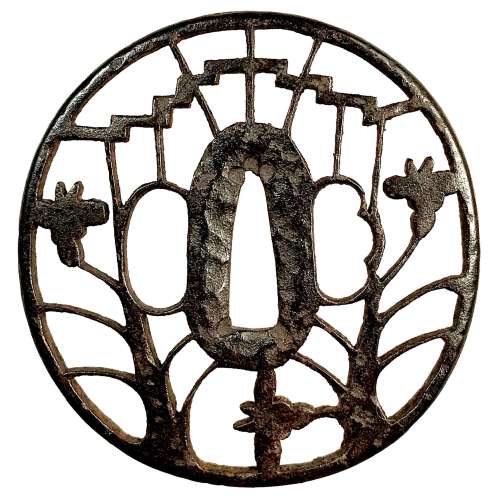
Kyo school iron tsuba of round form decorated with an eight-plank bridge (yatsuhashi) and irises (kakitsubata) in openwork (sukashi).
Late Muromachi period, Tenbun era (early 16th centiry).Dimensions: 80.0 x 77.2 x 4.1 mm.
The design alludes to the scene in 'Ise Monogatari', where Ariwara no Narihira being exiled from Kyoto to the Kanto region crossed the eight-plank bridge at Mikawa looking at the irises in bloom and composed a poem expressing his desire to return to Kyoto. A lot of tsuba have been produced with the similar design.
Reference: Masterpieces from the Sasano collection, 1994, p. 98, №69. -
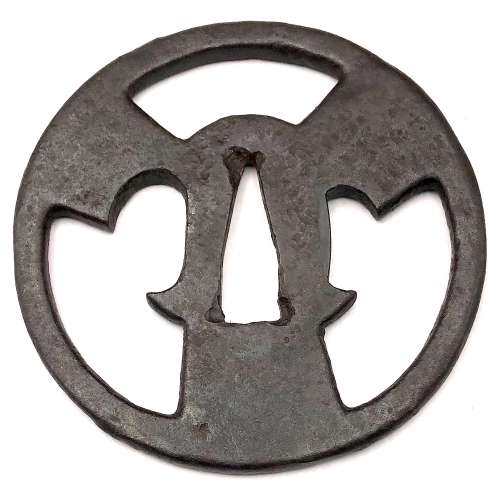 Iron tsuba of round form with three stylized folding fans motif in openwork (sukashi). Kogai-hitsu-ana with shakudō sekigane. Iron bones (tekkotsu) on the rim. Momoyama period or earlier. Possibly, Ko-Shōami school.
Iron tsuba of round form with three stylized folding fans motif in openwork (sukashi). Kogai-hitsu-ana with shakudō sekigane. Iron bones (tekkotsu) on the rim. Momoyama period or earlier. Possibly, Ko-Shōami school.Size: 76.8 x 75.7 x 4.0 mm.
[Seller alleged that the motif is "Buddhist wheel", which seems unlikely. -
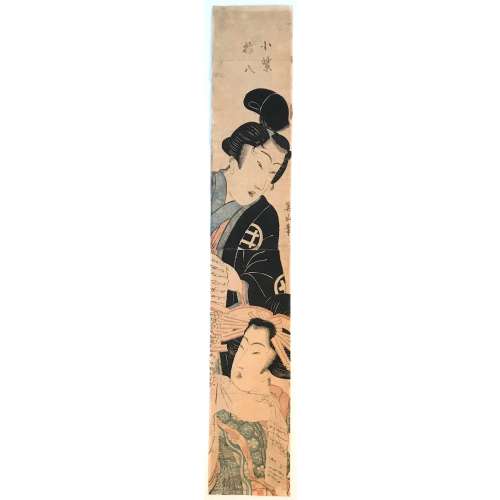 Kikukawa Eizan (菊川 英山, 1787 – July 17, 1867) Signed: Eizan hitsu (英山筆)
Kikukawa Eizan (菊川 英山, 1787 – July 17, 1867) Signed: Eizan hitsu (英山筆)Jacob Pins #972/p.341. Leiden, Rijksmuseum voor Volkenkunde.
"The Lovers Miura-ya Komurasaki and Shirai Gonpachi: Tragic love stories taken from real life and dramatized were a staple of stage and print; the darkly romantic combination of desire and death was hugely popular in the eighteenth century. Hirai Gompachi was a warrior of the Tottori fief in western Japan who fled to Edo after committing a murder. He was apprehended and sentenced to death in 1679. His distraught lover, the courtesan Komurasaki, committed suicide at his grave." [MET]
.
-
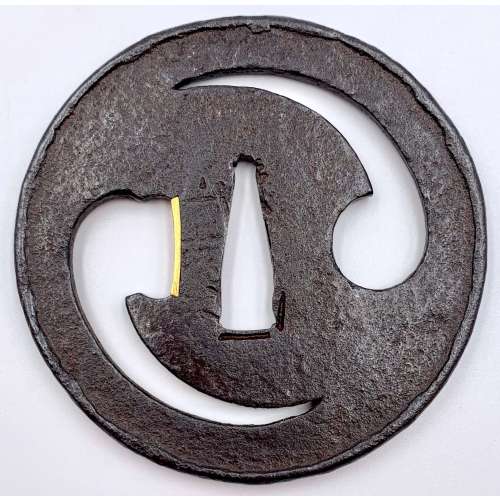
Circular tsuba (marugata ) with design of futatsu-domoe (twofold tomoe) in negative openwork (kage-sukashi), folded-over rim (uchikaeshi-mimi ). The ‘head’ of the left tomoe altered to form an opening for scabbard accessory (kata-hitsu-ana), adorned with gold ategane fitting with file marks (tate-yasurime). The hammer-blow finish of the surface (tsuchime-ji). Signed to the left of nakaga-ana: Yamakichibei (山吉兵). Attributed by Steve Waszak a the Second Generation (Nidai) master.
NBTHK paper [translated by Markus Sesko]:Tomoe-sukashi-tsuba (巴透し鐔).
KANTEI-SHO (鑑定書) - APPRAISAL No 451718
Futatsu-domoe sukashi-tsuba (二巴透鐔) ‒ Tsuba with two tomoe comma openwork design
Signed: Yamakichibei (山吉兵)
Round shape (marugata ), iron, hammerblow finish (tsuchime-ji ), negative openwork design (kage-sukashi ), folded-over rim (uchikaeshi-mimi ), one opening for scabbard accessory
(kata-hitsu-ana) (with gold ategane fitting)
According to the result of the shinsa committee of our society, we judge this work as authentic
and rank it as Hozon Tōsōgu.
February 20, 2007
[Foundation] Nihon Bijutsu Tōken Hozon Kyōkai, NBTHK (日本美術刀劍保存協會)
Diameter: 76 mm, thickness at center 3.9 mm, thickness at rim: 5.1 mm; weight: 102.5 g
Tomoe (Comma): The character 巴 (Chinese pronunciation bā). A pattern resembling the two-comma tomoe (futatsu-domoe) has been found in ancient cultures on all inhabited continents. ...aside from their military function, a ritual or fetish value, perhaps related to their testicular shape. It also has yin-yang connotation. The gold sekigane confirms the high value of the piece to the owner.
-
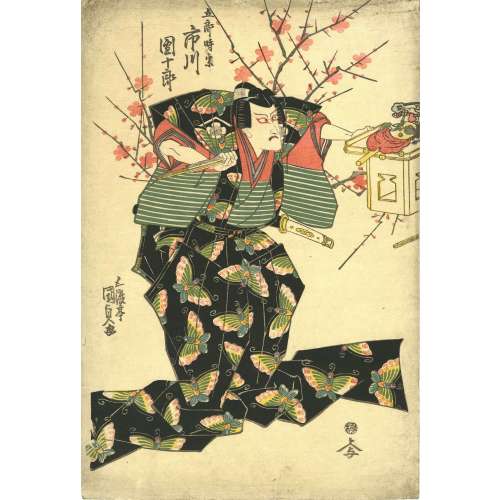 Actor Ichikawa Danjuro VII as Soga Goro Tokimune (one of the Soga brothers). Ichikawa Ebizô V held the name of Ichikawa Danjûrô VII from the 11th lunar month of 1800 to the 2nd lunar month of 1832. Artist: Utagawa Kunisada (Toyokuni III) [歌川 国貞] (Japanese, 1786 – 1865) Publisher: Uemura Yohei (Japanese, 1750 – 1832). Date: 1830 Size: Vertical ōban Signatures/Marks: Gototei Kunisada ga. Publisher's seal: Uemura Yohei. Censor's seal: Kiwame
Actor Ichikawa Danjuro VII as Soga Goro Tokimune (one of the Soga brothers). Ichikawa Ebizô V held the name of Ichikawa Danjûrô VII from the 11th lunar month of 1800 to the 2nd lunar month of 1832. Artist: Utagawa Kunisada (Toyokuni III) [歌川 国貞] (Japanese, 1786 – 1865) Publisher: Uemura Yohei (Japanese, 1750 – 1832). Date: 1830 Size: Vertical ōban Signatures/Marks: Gototei Kunisada ga. Publisher's seal: Uemura Yohei. Censor's seal: Kiwame -
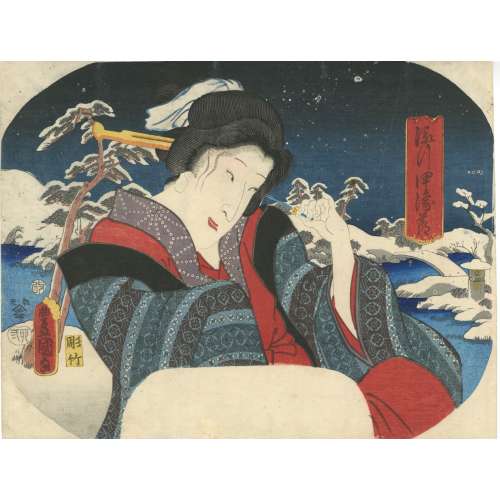 Artist: Utagawa Kunisada [歌川 国貞], a.k.a. Utagawa Toyokuni III [三代 歌川 豊国] (Japanese, 1786 – 1865). Signed: Toyokuni ga [豊国 画] in a red toshidama cartouche Block carver: Yokokawa Takejirō [横川竹二郎] (Japanese, fl. 1845 – 1863); seal: Hori Take [彫竹]. Publisher: Iseya Magobei [伊勢屋孫兵衛] (Japanese, fl. c. 1794 – 1868); seal: Hanmoto, Masu [板元, 益] (Marks 19-039 | 150d). Date-aratame seal: Ansei 2 (1855). Title: Time in Fukagawa, Iyo Province (Fukagawa Iyo setsu). Ref.: [LIB-3008.2022] Andreas Marks. Japanese woodblock prints: Artists, publishers and masterworks, 1680 – 1900. — Tuttle Publishing, 2010; p. 221. –> 1855 Kunisada. "Iyo Province-time at Fukagawa" (Fukagawa Iyo setsu). Fan print. Japan Ukiyo-e Museum, Matsumoto.
Artist: Utagawa Kunisada [歌川 国貞], a.k.a. Utagawa Toyokuni III [三代 歌川 豊国] (Japanese, 1786 – 1865). Signed: Toyokuni ga [豊国 画] in a red toshidama cartouche Block carver: Yokokawa Takejirō [横川竹二郎] (Japanese, fl. 1845 – 1863); seal: Hori Take [彫竹]. Publisher: Iseya Magobei [伊勢屋孫兵衛] (Japanese, fl. c. 1794 – 1868); seal: Hanmoto, Masu [板元, 益] (Marks 19-039 | 150d). Date-aratame seal: Ansei 2 (1855). Title: Time in Fukagawa, Iyo Province (Fukagawa Iyo setsu). Ref.: [LIB-3008.2022] Andreas Marks. Japanese woodblock prints: Artists, publishers and masterworks, 1680 – 1900. — Tuttle Publishing, 2010; p. 221. –> 1855 Kunisada. "Iyo Province-time at Fukagawa" (Fukagawa Iyo setsu). Fan print. Japan Ukiyo-e Museum, Matsumoto. -
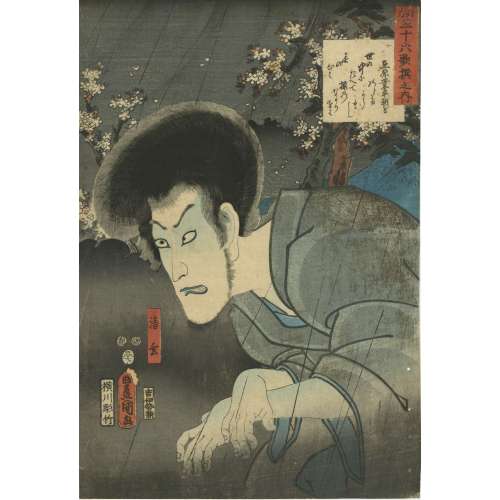 Poem by Ariwara no Narihira Ason: (Actor Ichikawa Danjûrô VIII as) Seigen, from the series Comparisons for Thirty-six Selected Poems (Mitate sanjûrokkasen no uchi)「見立三十六歌撰之内 有原業平朝臣 清玄」 八代目市川団十郎. Poem: Yo no naka ni/ taete sakura no/ nakariseba/ haru no kokoro wa/ nodokekaramashi. Kabuki actor: Ichikawa Danjūrō VIII [八代目 市川 團十郎] (Japanese, 1823 – 1854); other names: Ichikawa Ebizô VI, Ichikawa Shinnosuke II. Artist: Utagawa Kunisada [歌川 国貞] a.k.a. Utagawa Toyokuni III [三代歌川豊国] (Japanese, 1786 – 1865). Block cutter: Yokokawa Horitake [横川彫武] a.k.a. Yokokawa Takejiro [横川竹二郎] (Japanese, fl. 1860s). Publisher: Iseya Kanekichi [伊勢屋兼吉] (Japanese, fl. 1840s – c. 1875) Year: 1852 (Kaei 5), 10th month. Size: Vertical ōban; 36.5 × 25.4 cm. Signed: Toyokuni ga, in toshidama cartouche [豊国画(年玉枠] Censors' seals: Fuku, (Muramatsu), Rat 10. Ref: MFA Accession № 11.36779.43.
Poem by Ariwara no Narihira Ason: (Actor Ichikawa Danjûrô VIII as) Seigen, from the series Comparisons for Thirty-six Selected Poems (Mitate sanjûrokkasen no uchi)「見立三十六歌撰之内 有原業平朝臣 清玄」 八代目市川団十郎. Poem: Yo no naka ni/ taete sakura no/ nakariseba/ haru no kokoro wa/ nodokekaramashi. Kabuki actor: Ichikawa Danjūrō VIII [八代目 市川 團十郎] (Japanese, 1823 – 1854); other names: Ichikawa Ebizô VI, Ichikawa Shinnosuke II. Artist: Utagawa Kunisada [歌川 国貞] a.k.a. Utagawa Toyokuni III [三代歌川豊国] (Japanese, 1786 – 1865). Block cutter: Yokokawa Horitake [横川彫武] a.k.a. Yokokawa Takejiro [横川竹二郎] (Japanese, fl. 1860s). Publisher: Iseya Kanekichi [伊勢屋兼吉] (Japanese, fl. 1840s – c. 1875) Year: 1852 (Kaei 5), 10th month. Size: Vertical ōban; 36.5 × 25.4 cm. Signed: Toyokuni ga, in toshidama cartouche [豊国画(年玉枠] Censors' seals: Fuku, (Muramatsu), Rat 10. Ref: MFA Accession № 11.36779.43. -
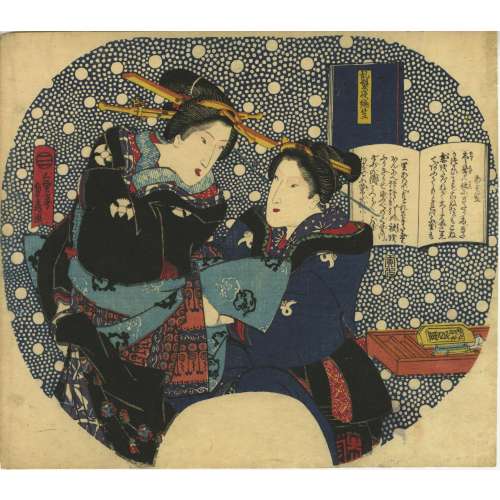 Artist: Utagawa Sadahide [歌川 貞秀], a.k.a. Gountei Sadahide [五雲亭 貞秀] (1807 – c. 1878/9). Signed: Gountei Sadahide ga [五雲亭貞秀画] Pubisher: Ibaya Senzaburō [伊場屋仙三郎] (Japanese, 1815 – 1869) Date-aratame seal: Bunsei 13 / Tenpō 1 (1830). Ref: Ritsumeikan University # Z0172-587. Title: Tangled Hair and the Evening Braided Hat [乱髪夜編笠] (Midaregami Yoru no Amigasa). The open book starts with the chapter title that reads Amigasa. This play was performed together with Kisohajime Hatsugai Soga [着衣始]初買曽我]. See the playbill for the performance at Moritaza at MFA (Boston) № 11.27208. 乱髪夜編笠(みだれがみよるのあみがさ。「夜の編笠」「白さぎ」
Artist: Utagawa Sadahide [歌川 貞秀], a.k.a. Gountei Sadahide [五雲亭 貞秀] (1807 – c. 1878/9). Signed: Gountei Sadahide ga [五雲亭貞秀画] Pubisher: Ibaya Senzaburō [伊場屋仙三郎] (Japanese, 1815 – 1869) Date-aratame seal: Bunsei 13 / Tenpō 1 (1830). Ref: Ritsumeikan University # Z0172-587. Title: Tangled Hair and the Evening Braided Hat [乱髪夜編笠] (Midaregami Yoru no Amigasa). The open book starts with the chapter title that reads Amigasa. This play was performed together with Kisohajime Hatsugai Soga [着衣始]初買曽我]. See the playbill for the performance at Moritaza at MFA (Boston) № 11.27208. 乱髪夜編笠(みだれがみよるのあみがさ。「夜の編笠」「白さぎ」とも)– one of the main melodies in katōbushi (河東節) type of jōruri [浄瑠璃]. For a detailed explanation in Japanese, see also HERE). A series of three prints is dedicated to a katōbushi performance of the Soga-themed plays.
They all have a background of hail patterns (Arare-ko-mon) [霰小紋], similar to Kunisada’s Iwai Kumesaburō II as An no Heibei [SVJP-0304.2019], see below.Yukari no Edo-zakura The tatami night robe of Iwao Tangled Hair and the Evening Braided Hat 
-
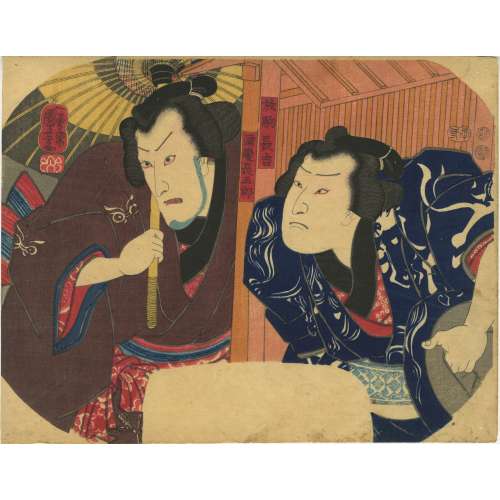 Artist: Utagawa Kuniyoshi [歌川 國芳] (1798 – 1861). Kabuki actors Ichikawa Danjūrō VIII and Arashi Rikan III as sumo wrestlers Nuregami Chōgorō (L) and Hanaregoma Chōkichi (R), respectively. Signed: Ichiyûsai Kuniyoshi ga (一勇斎 國芳 画) in a double gourd-shaped cartouche with Yoshi Kiri seal. Publisher: No seal. Date seal and double nanushi censor seal: Mera & Watanabe, 1852. Media: Fan print (uchiwa-e, 団扇絵), 231 x 295 mm. Theme: Nine-act drama (11 scenes) Futatsu Chōchō Kuruwa Nikki [双蝶々曲輪日記] (A Diary of Two Butterflies in the Pleasure Quarters) written by Takeda Izumo II, Namiki Senryū I, Miyoshi Shōraku (7/1749) as puppet play Bunraku [文楽], adopted for Kabuki theatre by Arashi San'emon IV. “The sumo wrestler Nuregami Chōgorō is trying to ransom the courtesan Azuma for Yogoro, in whose debt he stands. Hiraoka Goemon, who is at odds with Yogorō and Azuma, is the patron of the amateur wrestler Hanaregoma Chōkichi. Chōgorō purposely loses to Chōkichi and then asks the latter to stop Goemon's ransoming of Azuma; Chōkichi refuses, however, and they quarrel. Admonished for his dissipation by his sister Oseki, Chōkichi is going to commit ritual suicide (seppuku) as an apology for his behavior, but Chōgorō, who happens along just then, prevents him. The two men swear blood brotherhood. […] The confrontation between Chōgorō and Chōkichi in the Sumōba scene, acted in the exaggerated style called aragoto, is a major highlight of the work. The scene in Yohei's home, known as Hikimado, presents the unfolding of Kabuki's eternal conflict between duty and feelings, here represented by the act of opening the skylight (hikimado) to which Chōgorō is tied”. [Samuel L. Leiter. Kabuki Encyclopedia: an English-language adaptation of Kabuki Jiten. — Westport, CT; London: Greenwood Press, 1979, pp. 70-71]. See also James R. Brandon and Samuel L. Leiter. Kabuki plays on stage, vol. 1, pp. 234-258. — Honolulu: University of Hawai'i Press, 2002. Actors: Ichikawa Danjūrō VIII [市川団十郎] (Japanese, 1823 – 1854); other names: Ichikawa Ebizō VI, Ichikawa Shinnosuke II. Arashi Rikan III [嵐璃寛] (Japanese, 1812 – 1863); other names Arashi Tokusaburō III, Arashi Kicchō I, Onoe Wasaburō I. Another print in this collection with the same theme: SVJP-0331.2020.
Artist: Utagawa Kuniyoshi [歌川 國芳] (1798 – 1861). Kabuki actors Ichikawa Danjūrō VIII and Arashi Rikan III as sumo wrestlers Nuregami Chōgorō (L) and Hanaregoma Chōkichi (R), respectively. Signed: Ichiyûsai Kuniyoshi ga (一勇斎 國芳 画) in a double gourd-shaped cartouche with Yoshi Kiri seal. Publisher: No seal. Date seal and double nanushi censor seal: Mera & Watanabe, 1852. Media: Fan print (uchiwa-e, 団扇絵), 231 x 295 mm. Theme: Nine-act drama (11 scenes) Futatsu Chōchō Kuruwa Nikki [双蝶々曲輪日記] (A Diary of Two Butterflies in the Pleasure Quarters) written by Takeda Izumo II, Namiki Senryū I, Miyoshi Shōraku (7/1749) as puppet play Bunraku [文楽], adopted for Kabuki theatre by Arashi San'emon IV. “The sumo wrestler Nuregami Chōgorō is trying to ransom the courtesan Azuma for Yogoro, in whose debt he stands. Hiraoka Goemon, who is at odds with Yogorō and Azuma, is the patron of the amateur wrestler Hanaregoma Chōkichi. Chōgorō purposely loses to Chōkichi and then asks the latter to stop Goemon's ransoming of Azuma; Chōkichi refuses, however, and they quarrel. Admonished for his dissipation by his sister Oseki, Chōkichi is going to commit ritual suicide (seppuku) as an apology for his behavior, but Chōgorō, who happens along just then, prevents him. The two men swear blood brotherhood. […] The confrontation between Chōgorō and Chōkichi in the Sumōba scene, acted in the exaggerated style called aragoto, is a major highlight of the work. The scene in Yohei's home, known as Hikimado, presents the unfolding of Kabuki's eternal conflict between duty and feelings, here represented by the act of opening the skylight (hikimado) to which Chōgorō is tied”. [Samuel L. Leiter. Kabuki Encyclopedia: an English-language adaptation of Kabuki Jiten. — Westport, CT; London: Greenwood Press, 1979, pp. 70-71]. See also James R. Brandon and Samuel L. Leiter. Kabuki plays on stage, vol. 1, pp. 234-258. — Honolulu: University of Hawai'i Press, 2002. Actors: Ichikawa Danjūrō VIII [市川団十郎] (Japanese, 1823 – 1854); other names: Ichikawa Ebizō VI, Ichikawa Shinnosuke II. Arashi Rikan III [嵐璃寛] (Japanese, 1812 – 1863); other names Arashi Tokusaburō III, Arashi Kicchō I, Onoe Wasaburō I. Another print in this collection with the same theme: SVJP-0331.2020. Reference images:
Reference images:
-
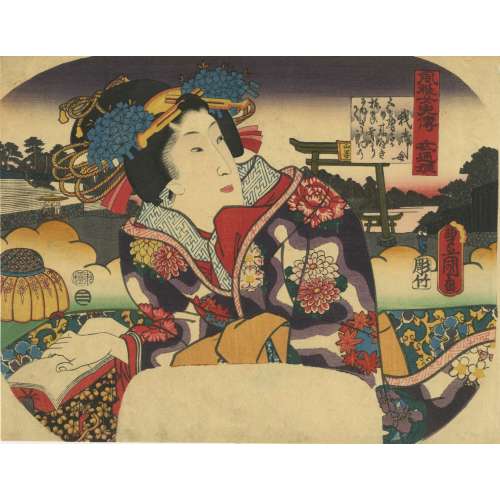 Artist: Utagawa Kunisada [歌川 国貞], a.k.a. Utagawa Toyokuni III [三代 歌川 豊国] (Japanese, 1786 – 1865). Signed: Toyokuni ga [豊国 画] in a red toshidama cartouche Block carver: Yokokawa Takejirō [横川竹二郎] (Japanese, fl. 1845 – 1863), seal: 彫竹 – hori Take. Publisher: Ibaya Senzaburō [伊場屋仙三郎] (Japanese, fl. c. 1845 – 1847). Media: Untrimmed fan print (uchiwa-e), 230 x 295 mm. Combined date seal and kiwame censor seal: Ansei 6 (1859). Title: Princess Sotoori [衣通姫] (Sotoori-hime) – Sotoori-hime was a concubine of Emperor Ingyo (reigned AD 412-53), and one of the Three Gods of Japanese Poetry [和歌三神] (Waka sanjin). Series: Chronicles of Elegant Women [風雅女史傳] (Fūga joshiden). The sign on the torii (Shinto shrine gates) reads: Mountain king shrine [山王宮] – it is the Sannō Shrine at the Nagata Riding Grounds in Edo. A print with these gates is at MFA (Boston) # 21.9853.
Artist: Utagawa Kunisada [歌川 国貞], a.k.a. Utagawa Toyokuni III [三代 歌川 豊国] (Japanese, 1786 – 1865). Signed: Toyokuni ga [豊国 画] in a red toshidama cartouche Block carver: Yokokawa Takejirō [横川竹二郎] (Japanese, fl. 1845 – 1863), seal: 彫竹 – hori Take. Publisher: Ibaya Senzaburō [伊場屋仙三郎] (Japanese, fl. c. 1845 – 1847). Media: Untrimmed fan print (uchiwa-e), 230 x 295 mm. Combined date seal and kiwame censor seal: Ansei 6 (1859). Title: Princess Sotoori [衣通姫] (Sotoori-hime) – Sotoori-hime was a concubine of Emperor Ingyo (reigned AD 412-53), and one of the Three Gods of Japanese Poetry [和歌三神] (Waka sanjin). Series: Chronicles of Elegant Women [風雅女史傳] (Fūga joshiden). The sign on the torii (Shinto shrine gates) reads: Mountain king shrine [山王宮] – it is the Sannō Shrine at the Nagata Riding Grounds in Edo. A print with these gates is at MFA (Boston) # 21.9853. Other prints from the same series in this collection:
SVJP-0343.2021 — Tamagiku:
Other prints from the same series in this collection:
SVJP-0343.2021 — Tamagiku:
 SVJP-0400.2023 — Saiko:
SVJP-0400.2023 — Saiko:
 Note: Special thanks to Horst Graebner, who helped decipher and understand the meaning.
Note: Special thanks to Horst Graebner, who helped decipher and understand the meaning.
-
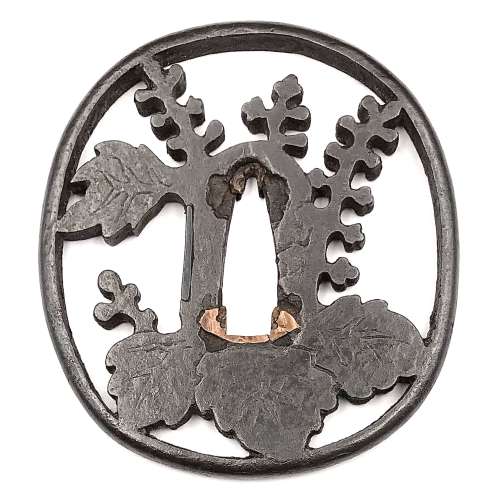 Iron tsuba of oval form with design of stylized paulownia (nage-giri) in openwork (sukashi). Leaf veins carved in kebori technique. Rounded rim. Copper sekigane. Unsigned. Attributed to Kanshirō, third generation Nishigaki (1680-1761). Edo period: Early 18th century (Kyoho / Genbun era). Size: Height: 77.8 mm. Width: 71.9 mm. Rim thickness: 5.9 mm. Center thickness: 5.0 mm. Provenance: Sasano Masayuki Collection, № 264: "Nishigaki. Third generation Kanshiro (died in in the eleventh year of Hohreki, 1761 at the age of eighty-two). This oblong shape appears a little amateurish at first, however, it was done intentionally to add flavor to to the design. The neat composition is a feature of the third Kanshiro."
Iron tsuba of oval form with design of stylized paulownia (nage-giri) in openwork (sukashi). Leaf veins carved in kebori technique. Rounded rim. Copper sekigane. Unsigned. Attributed to Kanshirō, third generation Nishigaki (1680-1761). Edo period: Early 18th century (Kyoho / Genbun era). Size: Height: 77.8 mm. Width: 71.9 mm. Rim thickness: 5.9 mm. Center thickness: 5.0 mm. Provenance: Sasano Masayuki Collection, № 264: "Nishigaki. Third generation Kanshiro (died in in the eleventh year of Hohreki, 1761 at the age of eighty-two). This oblong shape appears a little amateurish at first, however, it was done intentionally to add flavor to to the design. The neat composition is a feature of the third Kanshiro." -
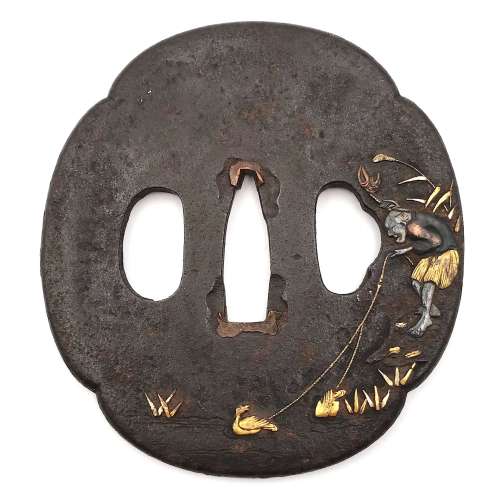 Mokkō form iron tsuba carved in relief and inlaid with soft metals (copper, gold, silver) with the design of a cormorant fisherman on the face and a boat on the reverse. Unsigned. Dimensions: 77 mm x 69 mm x 3.0 mm (at seppa-dai) Edo period: 18th or 19th century. "Since Nara period, Japanese fishermen in small boats have used cormorants (u) to catch river fish at night, binding the necks of the birds so that the fish are not swallowed. [...] The bird and the work it performs are symbols of selfless devotion to one's master and keen eyesight." - from Merrily Baird. Symbols of Japan. Thematic motifs in art and design. Rizzoli international publications, Inc., 2001; p. 104. See also in this collection TSU-0212 and TSU-0241.
Mokkō form iron tsuba carved in relief and inlaid with soft metals (copper, gold, silver) with the design of a cormorant fisherman on the face and a boat on the reverse. Unsigned. Dimensions: 77 mm x 69 mm x 3.0 mm (at seppa-dai) Edo period: 18th or 19th century. "Since Nara period, Japanese fishermen in small boats have used cormorants (u) to catch river fish at night, binding the necks of the birds so that the fish are not swallowed. [...] The bird and the work it performs are symbols of selfless devotion to one's master and keen eyesight." - from Merrily Baird. Symbols of Japan. Thematic motifs in art and design. Rizzoli international publications, Inc., 2001; p. 104. See also in this collection TSU-0212 and TSU-0241. -
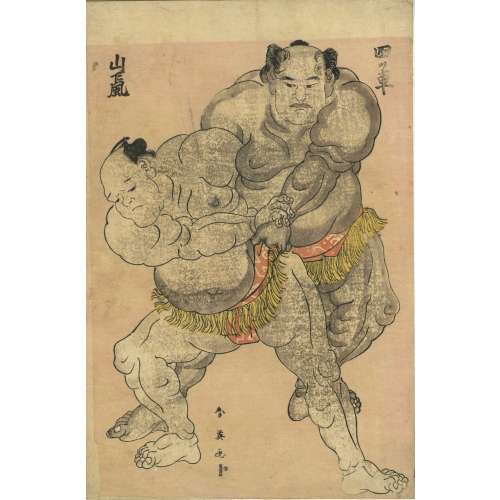 Katsukawa Shun'ei. The Sumo Bout between Yotsuguruma (right) and Yamaoroshi (left). Date: 1800 or 1805/06. Similar sheet can be found at Edo Tokyo Museum. Size: Vertical Ōban. Sumo wrestler Yotsuguruma Daihachi (1772 - 1809) first appeared in the records of national tournaments in winter of 1794. Then he lost 3 matches and won zero. He first won in the spring tournament of 1797 in a match against maegashira (the fifth-highest rank of sumo wrestlers) named Kougamine. Yamaoroshi Gengo (born 1762) came in at the winter tournament of 1799 . He was much more successful in his career than Yotsuguruma, but he had never won a tournament. It was the time of great Raiden, who won most of them. In the spring tournament of 1800 Yotsuguruma and Yamaoroshi fought against each other for the first time. Yotsuguruma lost. The next time they met on the ring was at the winter tournament of 1805, and again in 1806. Both matches were won by Yamaoroshi. Yamaoroshi retired in 1809; Yotsuguruma died in 1809.
Katsukawa Shun'ei. The Sumo Bout between Yotsuguruma (right) and Yamaoroshi (left). Date: 1800 or 1805/06. Similar sheet can be found at Edo Tokyo Museum. Size: Vertical Ōban. Sumo wrestler Yotsuguruma Daihachi (1772 - 1809) first appeared in the records of national tournaments in winter of 1794. Then he lost 3 matches and won zero. He first won in the spring tournament of 1797 in a match against maegashira (the fifth-highest rank of sumo wrestlers) named Kougamine. Yamaoroshi Gengo (born 1762) came in at the winter tournament of 1799 . He was much more successful in his career than Yotsuguruma, but he had never won a tournament. It was the time of great Raiden, who won most of them. In the spring tournament of 1800 Yotsuguruma and Yamaoroshi fought against each other for the first time. Yotsuguruma lost. The next time they met on the ring was at the winter tournament of 1805, and again in 1806. Both matches were won by Yamaoroshi. Yamaoroshi retired in 1809; Yotsuguruma died in 1809. -
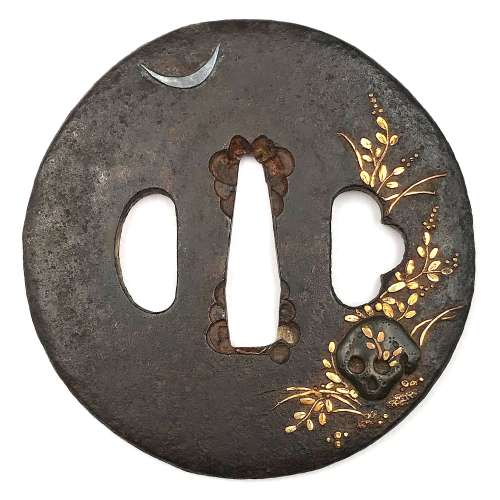 An iron tsuba of round shape inlaid with shakudō, gold, and silver with a motif of a weather-beaten (nozarashi) skull and grasses growing beside as well as through the eye-pit, and a crescent moon above the scene. Grasses on the reverse. Unsigned. Dimensions: 71.7 x 70.6 x 4.2 mm Reference: Skull, bones and grave markers SOLD
An iron tsuba of round shape inlaid with shakudō, gold, and silver with a motif of a weather-beaten (nozarashi) skull and grasses growing beside as well as through the eye-pit, and a crescent moon above the scene. Grasses on the reverse. Unsigned. Dimensions: 71.7 x 70.6 x 4.2 mm Reference: Skull, bones and grave markers SOLD -
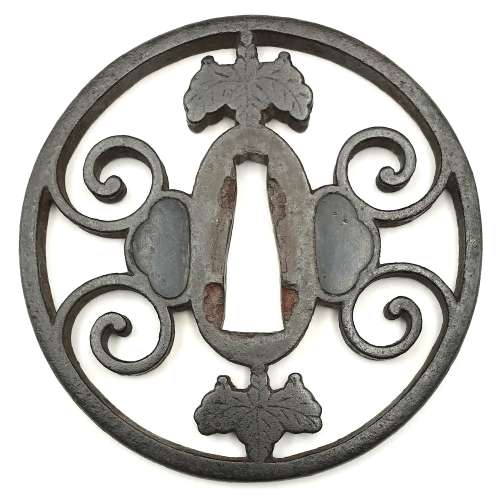
Iron tsuba of round form decorated with a design of bracken scrolls and paulownia leaves and blossoms (kiri-mon) in openwork (sukashi). Details carved in kebori. Squared rim with iron bones (tekkotsu). Hitsu-ana plugged with shakudō.
Size: 83.6 x 82.9 x 5.4 (center), 5.1 (rim) mm.
Unsigned.
Muromachi period, ca. 16th century.







